The Value of a Decrease in Temperature by One Degree Celsius of the Regional Microclimate—The Cooling Effect of the Paddy Field
Abstract
1. Introduction
- Quantifying the difference in temperature between paddy fields and urban areas using remote sensing
- Quantifying the ability of paddy fields to reduce the heat island effect
- Employing the contingent valuation method (CVM) to estimate the economic value of the paddy field cooling effect
2. The Cooling Effect of Paddy Fields
2.1. Research Area and Methodology
2.2. Research Software and Satellite Images
2.3. Surface Temperature Deduction
- Transform the radiation correction coefficient to the atmosphere’s long-wave radiation intensity L6, TOA (mW/m2-sr-μm) by the formulawhere DN is the digital number of the image and Lmax and Lmin are the detectable maximum and minimum radiation levels in the scene, respectively.
- Use Planck’s law to transform the spectrum radiation quantity to the satellite radiation temperature Tsat (K).
- Transform the atmosphere’s long-wave radiation intensity according to the Stefan-Boltzmann law and use the survey ground emission long-wave radiation quantity information and the atmosphere’s long-wave radiation quantity obtained from the satellite image to calculate the linear regression and the ground temperature T0(°C) by the following equation:where is the long-wave emissivity of the land surface.
2.4. Ground Calibrations
2.5. Result of Analysis of the Surface Temperature
- In the Taoyuan research area, the surface temperature of the paddy field is 2.5 °C lower than in all the areas, on average, while that in the Hsinchu research area is 3.3 °C lower. These two studies show that the average paddy field temperature is 2.9 °C lower than the regional average.
- The surface temperature in the entire Taoyuan region was 1.2 °C higher in 2002 than in 2003 according to satellite analysis. The result of another analysis also showed that the temperature of the paddy field point was approximately 6.6 °C lower than that of building and road point and approximately 2.6 °C lower than that of the bare land point, on average.
- The surface temperature in the entire Hsinchu region was 1.5 °C higher in 2002 than in 2003 according to satellite analysis. Due to the fallowing in both 2002 and 2003, the surface temperature in the paddy fields was higher by 1.6 °C in 2002 than in 2003. Another analysis also showed that the temperature of the paddy field point was approximately 7.7 °C lower than that of building and road point and approximately 4.3 °C lower than that of the bare land point. In 2003, the temperature of the paddy field point was approximately 10.1 °C lower than that of the building and road point and approximately 8.3 °C lower than that of the bare land point, on average.
2.6. Influence of a Fallow Period of Paddy Cultivation on Temperature in a Micro-Area
- The average surface temperature in 2003 was 3.07 °C higher than in 2002.
- In the year 2002, after adjustment, the average temperature of 23.28 °C changed to 23.37 °C after 100 m buffer analysis and to 23.44 °C after 200 m. Between 300 m and 1000 m, the average temperatures were as follows: 23.57 °C, 24.06 °C, 24.08 °C, 24.09 °C, 24.16 °C, 24.20 °C, 24.27 °C, and 24.32 °C, respectively. This proves that paddy fields have the effect of decreasing the regional average temperatures of their surroundings, depending upon the man-made land use. They also have positive effects on their neighboring areas although the effect of a decrease in temperature as the distance increases is not very obvious.
- In the year 2003, the average temperature of 26.35 °C changed to 25.16 °C after 100 m buffer analysis and to 25.31 °C after 200 m. Between 300 m and 1000 m, the average temperatures were as follows: 25.31 °C, 25.98 °C, 25.27 °C, 25.39 °C, 25.73 °C, 24.87 °C, 25.13 °C, and 25.56 °C, respectively. The fallowed paddy field did not have the same positive influence on the regional average temperature.
3. Contingent Valuation Method (CVM)
3.1. Theoretical and Empirical Model of the Contingent Valuation Method (CVM)
3.2. Questionnaire and Sampling Design
3.3. Sampling Design and Empirical Results
3.4. The Economic Value of the Paddy Field Cooling Effect in Taiwan
3.5. The Value of a Decrease of 1 °C in the Regional Microclimate in Taiwan by Applying the Benefits Transfer Method
4. Conclusions
- The result of overall surface temperature deductive analysis revealed that the temperature in the whole Taoyuan research area was 1.2 °C higher in 2002 than in 2003 because of fallowing of the paddy field, while in the Hsinchu research area, it was 1.5 °C higher in 2002 than in 2003, due to the same reason described above.
- In terms of the difference in land use, the result of surface temperature deduction showed that the average paddy field temperature in 2002 was 25.0 °C (sample area average), which was 6.6 °C lower than that of the building and road point and 2.6 °C lower than that of the bare land point. The average paddy field temperature in 2003 was 23.6 °C (sample area average), which was 7.2 °C lower than that of the building and road point and 8.3 °C lower than that of the bare land point.
- As for the Hsinchu research area, the surface temperature deductive result showed that the average paddy field temperature in 2002 was 22.3 °C (sample area average), which was 7.7 °C lower than that of the building and road point and 4.3 °C lower than that of the bare land point. The average paddy field temperature in 2003 was 19.2 °C (sample area average), which was 10.1 °C lower than that of the building and road point and 8.3 °C lower than that of the bare land point.
- After adjusting for average differences, the average temperature of the Gobei work group was 23.28 °C in 2002, which was 3.0 °C lower than in 2003. Using the Gobei area as a datum, by applying the GIS to undertake buffer analysis from 100 m to 1000 m, with every 100 m as a buffer unit, surface temperature calculations showed that the regional average temperature was lower in the paddy fields in 2002 and higher during fallow. This is the positive effect on the temperature of the surrounding areas under the existence of paddy cultivation.
- This paper unambiguously concludes that the shift of agricultural water resources to meet the needs of the non-agriculture sector by practicing fallowing of paddy fields is not only at the cost of interrupting the agricultural production but also at the cost of sacrificing the comfort of people in the hot season.
- By using the CVM model, it was found that the respondents in Taiwan are willing to pay an additional 8.89 USD/per kg rice/year for the paddy to decrease the temperature by 1 °C in the regional microclimate due to the paddy field cooling effect.
- Applying the benefits transfer method, it was found that the economic value of a temperature decrease of 1 °C in the regional microclimate in Taiwan amounted to 9,693,144,279 USD/year.
- If the paddy fields near urban areas are converted to built-up areas continuously, the urban heat island effect may become more significant, along with other harmful results, such as concentrated rainfall, floods, droughts, and harvest shortfall. In conclusion, more caution is needed while making decisions to change the land use of paddy fields to other land uses.
Author Contributions
Funding
Institutional Review Board Statement
Informed Consent Statement
Data Availability Statement
Conflicts of Interest
References
- Cheng, K.S.; Su, Y.F.; Kuo, F.T.; Hung, W.C.; Chiang, J.L. Assessing the effect of landcover changes on air temperature using remote sensing images—A pilot study in northern Taiwan. Landsc. Urban Plan. 2008, 85, 85–96. [Google Scholar] [CrossRef]
- Yokohari, M.; Brownb, R.D.; Katoc, Y.; Yamamoto, S. The cooling effect of paddy fields on summertime air temperature in residential Tokyo, Japan. Landsc. Urban Plan. 2001, 53, 17–27. [Google Scholar] [CrossRef]
- Terjung, W.H.; Mearns, L.O.; Todhunter, P.E.; Hayes, J.T.; Ji, H.-Y. Effects of monsoonal fluctuations on grains in China. Part II: Crop water requirements. J. Clim. 1989, 2, 19–37. [Google Scholar] [CrossRef]
- Tsai, J.L.; Tsuang, B.J.; Lu, P.S.; Yao, M.H.; Shen, Y. Surface energy components and land characteristics of a rice paddy. J. Appl. Meteorol. Climatol. 2007, 46, 1879–1900. Available online: http://www.jstor.org/stable/26172104 (accessed on 25 January 2021). [CrossRef]
- Liu, T.; Yu, L.; Zhang, S. Land surface temperature response to irrigated paddy field expansion: A case study of semi-arid western Jilin Province, China. Sci. Rep. 2019, 9, 1–8. [Google Scholar] [CrossRef] [PubMed]
- Kalnay, E.; Cai, M. Impact of urbanization and land-use change on climate. Nature 2003, 423, 528–531. [Google Scholar] [CrossRef]
- Sun, C.Y. The relationship between green roofs and the thermal environment in Taipei city. WIT Trans. Ecol. Environ. 2010, 138, 77–88. [Google Scholar]
- Chen, Y.C.; Tan, C.H.; Wei, C.; Su, Z.W. Cooling Effect of Rivers on Metropolitan Taipei Using Remote Sensing. Int. J. Environ. Res. Public Health 2014, 11, 1195–1210. [Google Scholar] [CrossRef] [PubMed]
- Yoshida, R.; Iizumi, T.; Nishimori, M. Impact functions for land-use-induced surface warming, and their applications in uncertainty analysis. Clim. Res. 2014, 59, 77–87. [Google Scholar] [CrossRef][Green Version]
- Tan, C.H.; Chu, T.W.; Jao, C.C. Cooling effect range assessment of paddy fields in urban neighborhood by Landsat thermal imagery. In Proceedings of the 32nd Asian Conference on Remote Sensing, Taipei, Taiwan, 3–7 October 2011; pp. 1857–1862. [Google Scholar]
- Hutchison, B.A.; Taylor, F.G. Energy conservation mechanisms and potentials of landscape design to ameliorate building microclimates. Landsc. J. 1983, 2, 19–39. [Google Scholar] [CrossRef]
- Thiery, W.; Visser, A.J.; Fischer, E.M.; Hauser, M.; Hirsch, A.L.; Lawrence, D.M.; Lejeune, Q.; Davin, E.L.; Seneviratne, S.I. Warming of hot extremes alleviated by expanding irrigation. Nat. Commun. 2020, 11, 1–7. [Google Scholar] [CrossRef] [PubMed]
- Chiueh, Y.W.; Tan, C.H.; Hsu, H.Y. How much does 1 degree Celsius worth? -The economic value of paddy field Heat Sink Effect evaluate by the Contingent Valuation Method. In Proceedings of the International Commission on Irrigation and Drainage 2015, 26th Euro-Mediterranean Regional Conference and Workshops Innovate to improve Irrigation performances, Montpellier, France, 12–15 October 2015. [Google Scholar]
- Water Resource Agency. Available online: https://www.wra.gov.tw/cl.aspx?n=18763 (accessed on 19 February 2021).
- Ajaz, A.; Taghvaeian, S.; Khand, K.; Gowda, P.H.; Moorhead, J.E. Development and evaluation of an agricultural drought index by harnessing soil moisture and weather data. Water 2019, 11, 1375. [Google Scholar] [CrossRef]
- Lian, C.S.; Cheng, K.S.; Jheng, K.S.; Chen, P.Y.; Shen, L.Y. Establishment of the Meteorological of Drought Indicators in Taiwan and Case Analysis of Events. In Proceedings of the 2018 Weather Analysis and Forecast Conference, Central Weather Bureau, Taipei, Taiwan, 11–13 September 2018. [Google Scholar]
- Hung, C.W.; Shih, M.F. Analysis of Severe Droughts in Taiwan and its Related Atmospheric and Oceanic Environments. Atmosphere 2019, 10, 159. [Google Scholar] [CrossRef]
- Campbell, J.B. Introduction to Remote Sensing; The Guilford Press: New York, NY, USA, 1987; p. 203. [Google Scholar]
- Chiueh, Y.W. Environmental Multifunctionality of Paddy Fields in Taiwan—A Conjunction Evaluation Method of Contingent Valuation Method and Analytic Network Procedures. Environ. Nat. Resour. Res. 2012, 2, 114–127. [Google Scholar] [CrossRef][Green Version]
- Chiueh, Y.W.; Chen, M.C. Environmental multifunctionality of paddy fields in Taiwan: An application of contingent valuation method. Paddy Water Environ. 2008, 6, 229–236. [Google Scholar] [CrossRef]
- Cameron, T.A. A new paradigm for valuing non-market goods using referendum data: Maximum likelihood estimation by censored logistic regression. J. Environ. Econ. Manag. 1988, 15, 355–379. [Google Scholar] [CrossRef]
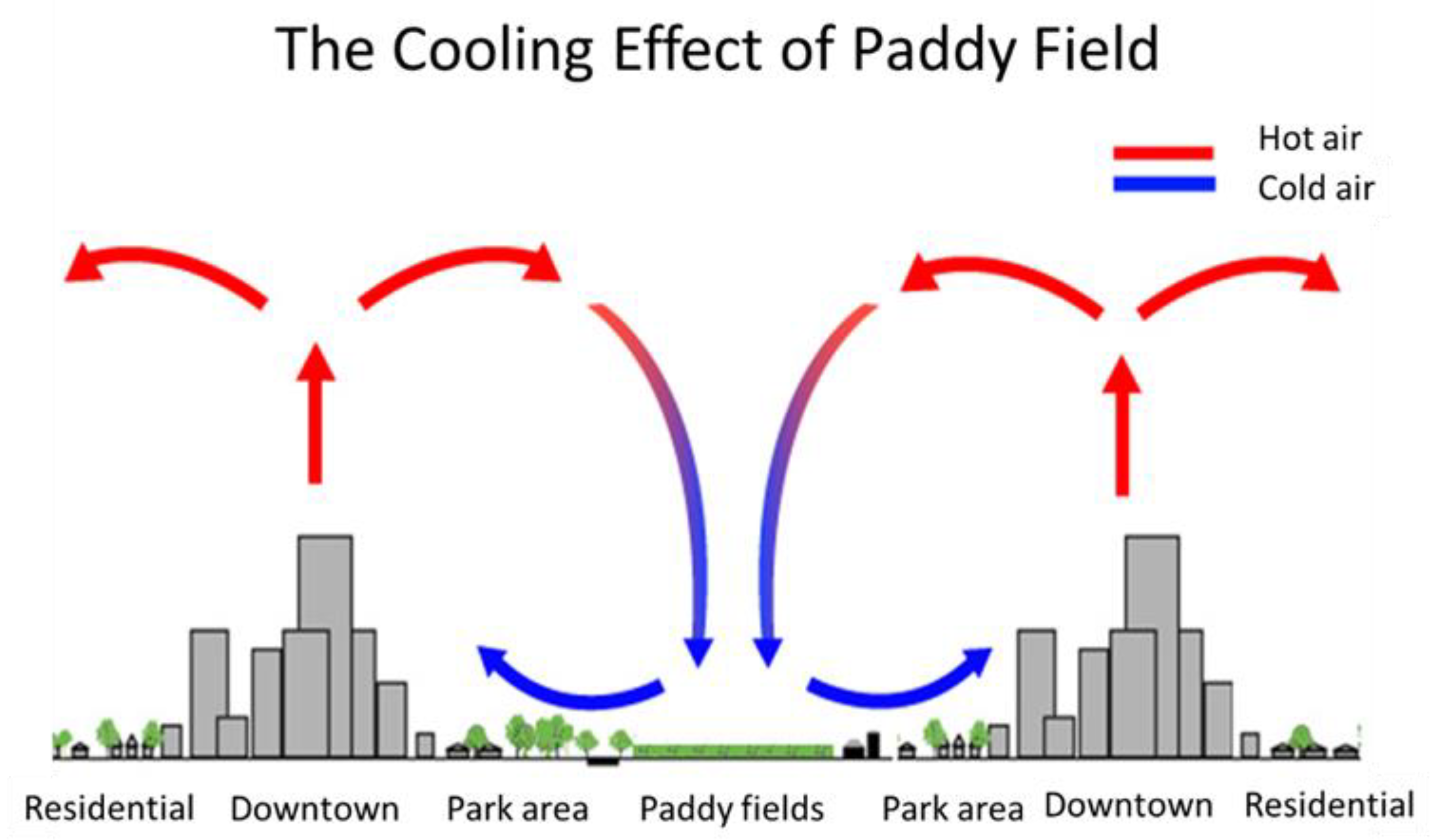
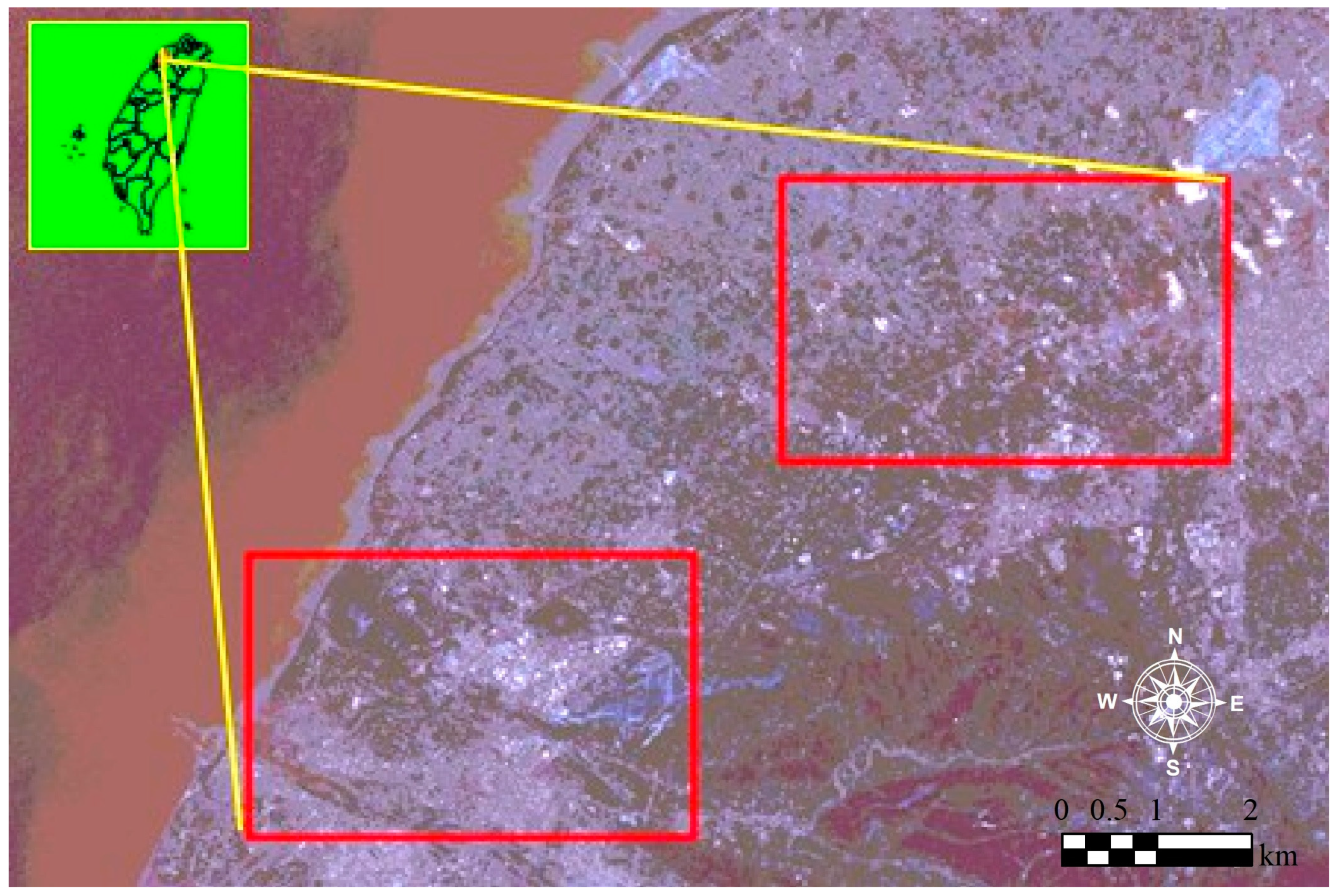
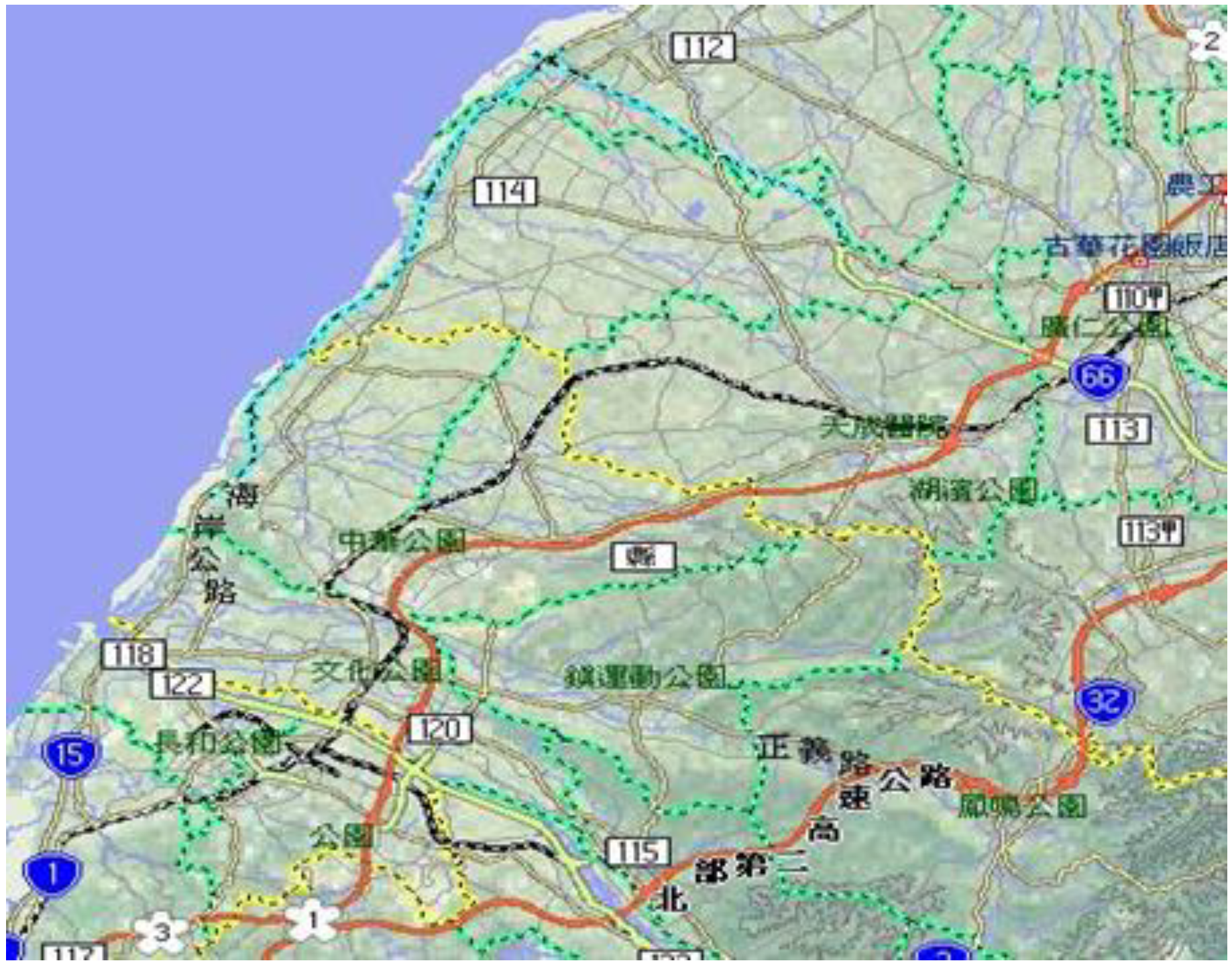
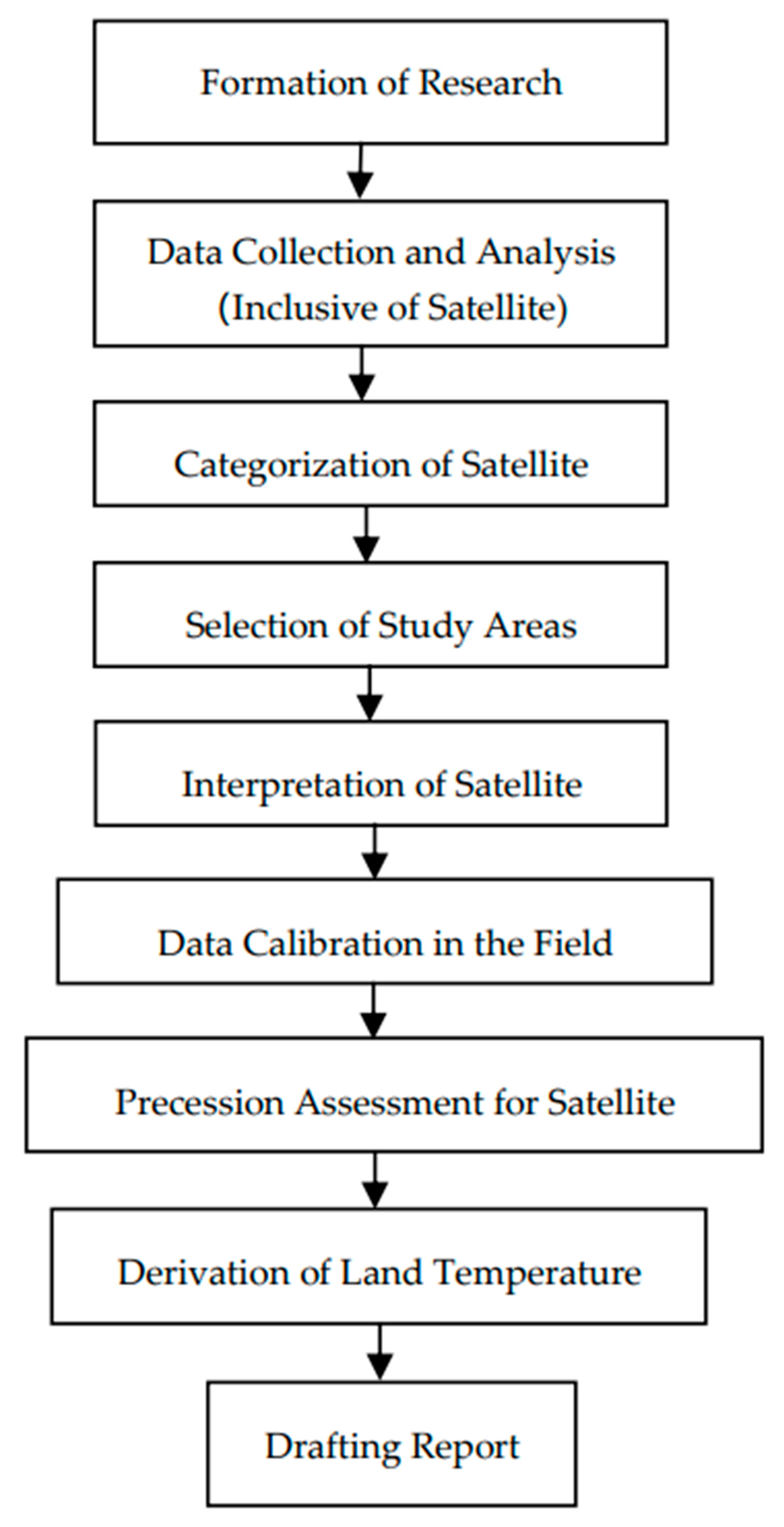
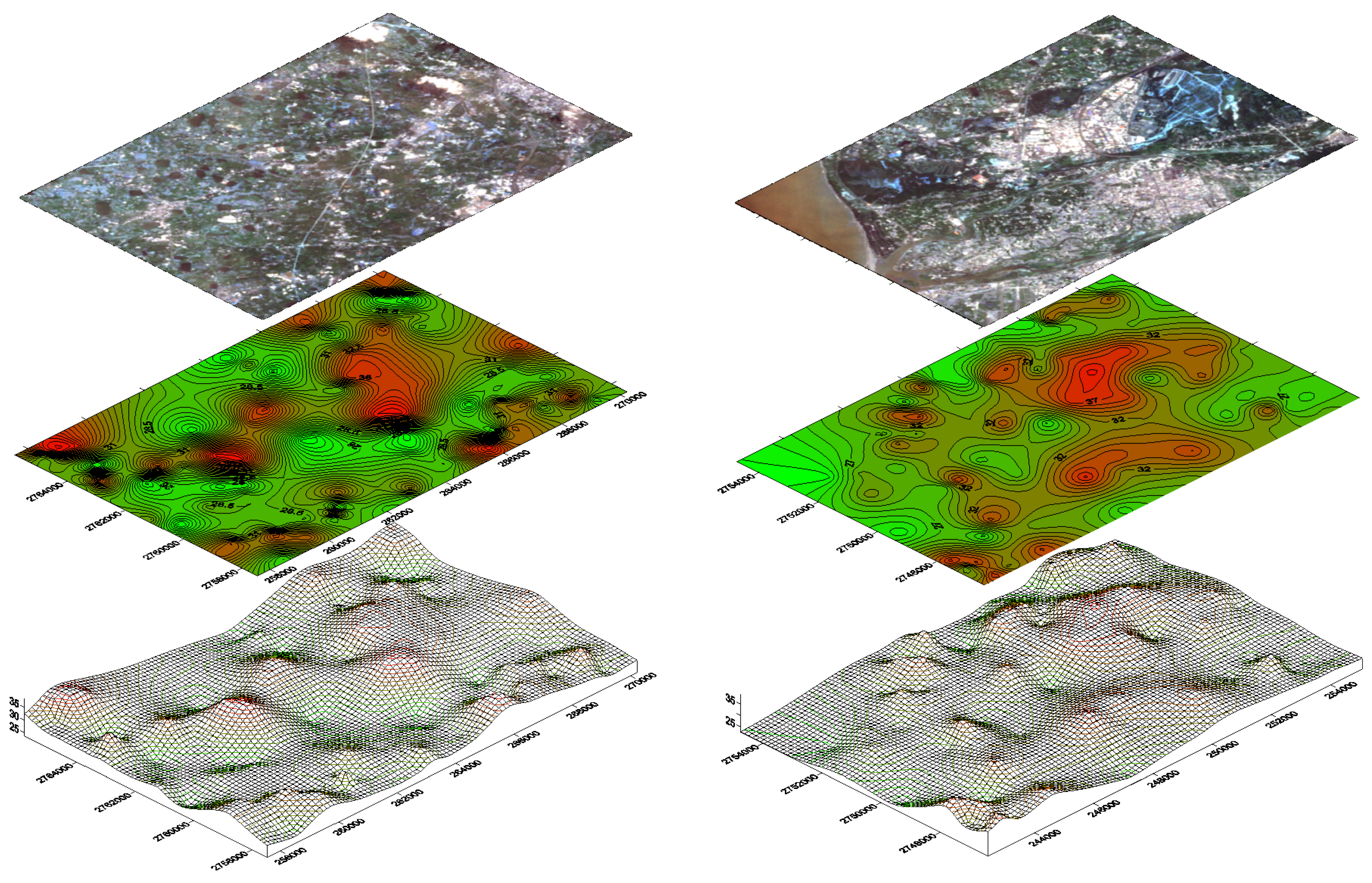
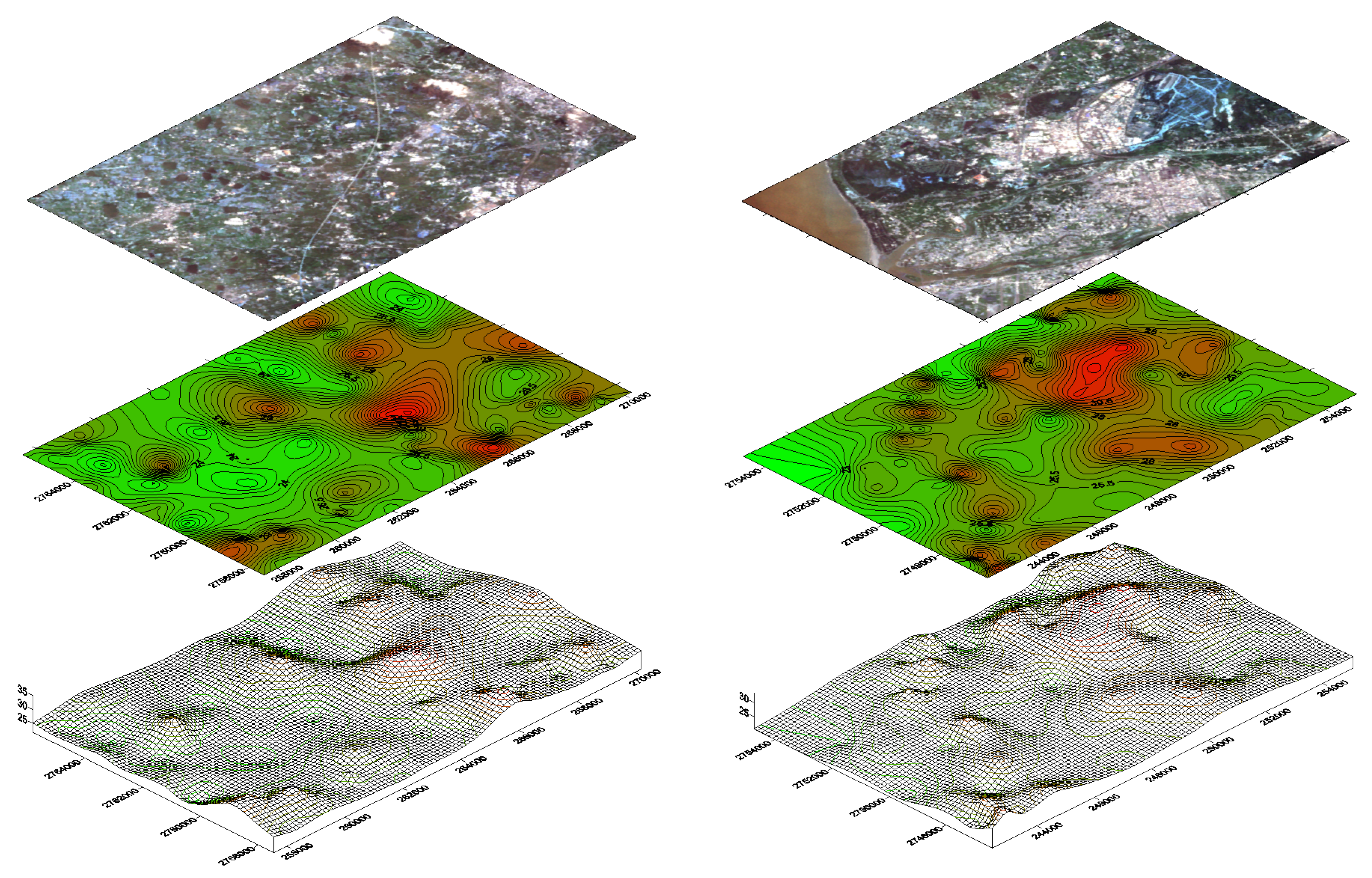

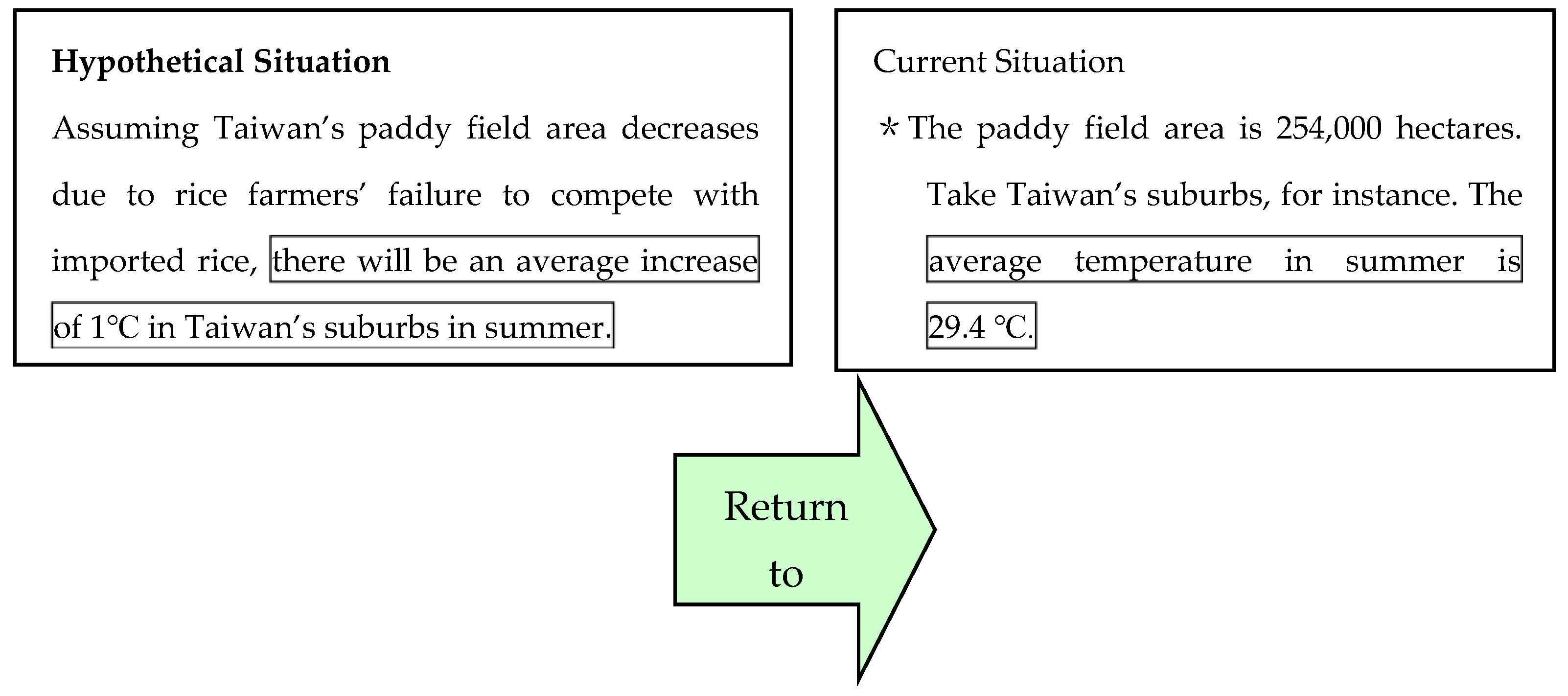
| Land Use | Taoyuan Area | Hsinchu Area |
|---|---|---|
| Paddy point | 23 | 21 |
| Water body point | 15 | 10 |
| Buildings and road point | 21 | 29 |
| Pasture and upland crop point | 23 | 23 |
| Natural forest point | 23 | 13 |
| Bare land (fallow) point | 11 | 19 |
| Total | 114 | 115 |
| Land Use | Taoyuan Area | Hsinchu Area | ||||
|---|---|---|---|---|---|---|
| 2002 | 2003 | Temperature after Adjustment 2002 | 2002 | 2003 | Temperature after Adjustment 2002 | |
| Entire research region | 27.5 | 26.3 | 26.3 | 25.6 | 24.1 | 24.1 |
| Paddy field point | 25.0 | 23.6 | 23.8 | 22.3 | 19.2 | 20.8 |
| Water body point | 23.4 | 19.9 | 22.2 | 19.7 | 15.2 | 18.2 |
| Buildings and road point | 31.6 | 30.8 | 30.4 | 30.0 | 29.3 | 28.5 |
| Pasture and upland crop point | 26.5 | 24.4 | 25.3 | 24.3 | 22.1 | 22.8 |
| Natural forest point | 26.0 | 24.5 | 24.8 | 24.2 | 21.6 | 22.7 |
| Bare land point | 27.6 | 32.0 | 26.4 | 27.6 | 27.5 | 26.1 |
| Buffer Distance | Average Temperature in 2002 | Average Temperature in 2003 | Temperature after Adjustment in 2002 |
|---|---|---|---|
| Whole research area | 25.64 | 24.07 | 24.07 |
| Gobei work group | 24.85 | 26.35 | 23.28 |
| 100 m | 24.94 | 25.16 | 23.37 |
| 200 m | 25.01 | 24.98 | 23.44 |
| 300 m | 25.14 | 25.31 | 23.57 |
| 400 m | 25.63 | 25.98 | 24.06 |
| 500 m | 25.65 | 25.27 | 24.08 |
| 600 m | 25.66 | 25.39 | 24.09 |
| 700 m | 25.73 | 25.73 | 24.16 |
| 800 m | 25.77 | 24.87 | 24.20 |
| 900 m | 25.84 | 25.13 | 24.27 |
| 1000 m | 25.89 | 25.56 | 24.32 |
| Targets of Distribution | Government | Academia | All Questionnaires |
|---|---|---|---|
| Date of questionnaire distribution | 23 August 2010 | 23 August 2010 15 September 2010 | 15 September 2010 |
| No. of copies distributed | 150 | 132 | 282 |
| Date of recovery | 15 September 2010 | 15 September 2010 17 September 2010 | 17 September 2010 |
| No. of copies recovered | 80 | 71 | 151 |
| The ratio of questionnaire recovery (%) | 53.3% | 53.7% | 53.5% |
| No. of valid questionnaire copies | - | - | 145 |
| Valid questionnaire recovery rate (%) | - | - | 51.42% |
| Mean | Standard Deviation | Skewness | Kurtosis | Remark (Variable Setting) | |
|---|---|---|---|---|---|
| Price inquiry in amount | 41.1788 | 74.3101 | 2.29374 | 7.48667 | As shown in the setting in Table 1 |
| Information | 10.8411 | 5.13821 | −0.25954 | 3.72251 | Scored according to the first part of the questionnaire |
| Gender | - | - | - | - | Male 1 Female 0 |
| No. of people in the household | 3.76351 | 1.78947 | 2.30181 | 17.041 | - |
| Empirical Results of the LOGIT Model | Coefficient | Standard Deviation | T-Value | p-Value | |
|---|---|---|---|---|---|
| Intercept | 0.331107 | 0.994749 | 0.332854 | 0.739244 | |
| Price inquiry in amounts | −0.00927 | 0.002712 | −3.41849 | 0.00063 | |
| Information | 0.116233 | 0.04921 | 2.36197 | 0.018178 | |
| Gender | −0.55573 | 0.60415 | −0.91986 | 0.357649 | |
| No. of people in the household | 0.153417 | 0.143974 | 1.06559 | 0.286609 | |
| Area of residence | 0.191724 | 0.166258 | 1.15317 | 0.24884 | |
| Correct prediction = actual 1 s and 0 s correctly predicted, 87.407%. | |||||
| WTPTEM = 8.89 USD/kg rice/year (249 NTD/kg rice; the exchange rate is 28 New Taiwan dollars for 1 US dollar). | |||||
| Willingness to Pay (WTP) 1 (USD/kg Rice/Year) 4 | Population in Taiwan in 2019 2 | Average Rice Consumed by Every Household in 2019 3 (kg) | Economic Value (USD/Year) |
|---|---|---|---|
| 8.89 | 23,603,121 | 46.18 | 9,693,144,279 |
Publisher’s Note: MDPI stays neutral with regard to jurisdictional claims in published maps and institutional affiliations. |
© 2021 by the authors. Licensee MDPI, Basel, Switzerland. This article is an open access article distributed under the terms and conditions of the Creative Commons Attribution (CC BY) license (http://creativecommons.org/licenses/by/4.0/).
Share and Cite
Chiueh, Y.-W.; Tan, C.-H.; Hsu, H.-Y. The Value of a Decrease in Temperature by One Degree Celsius of the Regional Microclimate—The Cooling Effect of the Paddy Field. Atmosphere 2021, 12, 353. https://doi.org/10.3390/atmos12030353
Chiueh Y-W, Tan C-H, Hsu H-Y. The Value of a Decrease in Temperature by One Degree Celsius of the Regional Microclimate—The Cooling Effect of the Paddy Field. Atmosphere. 2021; 12(3):353. https://doi.org/10.3390/atmos12030353
Chicago/Turabian StyleChiueh, Ya-Wen, Chih-Hung Tan, and Hsiang-Yi Hsu. 2021. "The Value of a Decrease in Temperature by One Degree Celsius of the Regional Microclimate—The Cooling Effect of the Paddy Field" Atmosphere 12, no. 3: 353. https://doi.org/10.3390/atmos12030353
APA StyleChiueh, Y.-W., Tan, C.-H., & Hsu, H.-Y. (2021). The Value of a Decrease in Temperature by One Degree Celsius of the Regional Microclimate—The Cooling Effect of the Paddy Field. Atmosphere, 12(3), 353. https://doi.org/10.3390/atmos12030353






